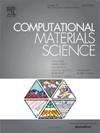Algorithmic solutions for the generation of digital material representation models of thin films and coatings
IF 3.1
3区 材料科学
Q2 MATERIALS SCIENCE, MULTIDISCIPLINARY
引用次数: 0
Abstract
The structure of thin films and coatings is frequently complex due to the nature of deposition processes. It consists of columns with intercolumnar boundaries that are often precursors of crack initiation and propagation, which can lead to delamination of the film from the substrate. The simulation of the behaviour of thin film and coatings without considering their complex morphology presents a significant limitation in achieving reliable results. Therefore, to address this challenge, a set of approaches for generating a full-field digital representation of thin films/coatings for subsequent numerical studies was developed within the work. These algorithms are divided into three categories characterised by different levels of complexity. The first is based on image processing algorithms for directly mapping the exact morphology of films/coatings from experimental data. The second is based on the cellular automata and Monte Carlo algorithms, providing a statistically similar representation of films/coatings structures. Finally, the third uses physics-based modelling methods to replicate the deposition process of films/coatings on the substrate. The methodologies outlined in this work facilitate the preparation of digital morphologies of any complex deposited structure for subsequent incorporation into numerical simulations examining their behavior under processing and in-use conditions. This enables the use of numerical methods in the detailed investigation of deposited structures designed for practical applications in a wide range of industries, which is important from an ecological and economic point of view.

求助全文
约1分钟内获得全文
求助全文
来源期刊

Computational Materials Science
工程技术-材料科学:综合
CiteScore
6.50
自引率
6.10%
发文量
665
审稿时长
26 days
期刊介绍:
The goal of Computational Materials Science is to report on results that provide new or unique insights into, or significantly expand our understanding of, the properties of materials or phenomena associated with their design, synthesis, processing, characterization, and utilization. To be relevant to the journal, the results should be applied or applicable to specific material systems that are discussed within the submission.
 求助内容:
求助内容: 应助结果提醒方式:
应助结果提醒方式:


